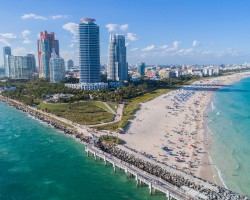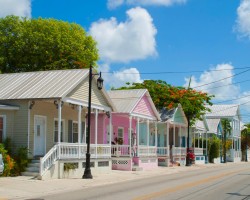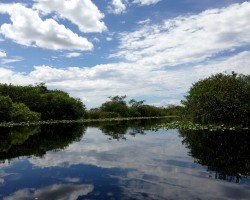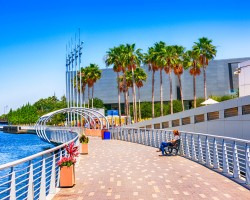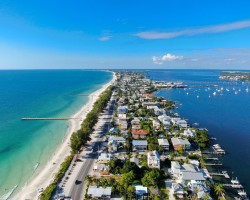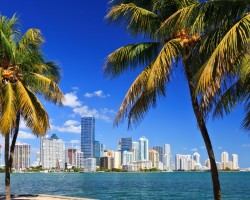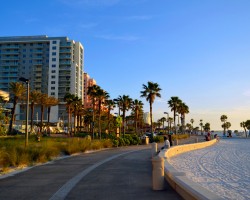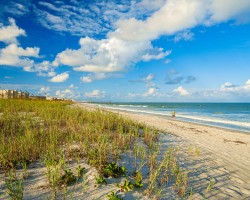Best time to go to Florida for a perfect weather and where to go?
When is the best time to go to Florida?
The best time to visit Florida is from November to May. However, the wetter season, between June and October, should not be ruled out, as it is still warm. Rightfully nicknamed the "Sunshine State," Florida is characterized by 240 days of sunshine per year and this state has plenty to offer all year round.
The peak tourist season is in March and especially in December. Indeed, many tourists, as well as Americans, want to spend the end-of-year holidays in the sun. February and April are a bit less crowded but still very busy. This is the period of Spring Break: for a week, American students are on vacation, but the period extends from late February to early April, as it does not occur at the same time in all states. To ensure the best weather conditions, they flock to Florida, especially to Miami and the coastal cities nearby like Hollywood Beach or Fort Lauderdale. The beaches are then crowded and host monumental parties. If you are planning a trip to Florida during these months, make sure to make your reservations as soon as possible, as everything fills up quickly. Additionally, February and March are the most expensive times of the year for accommodation.
To fully enjoy the beach pleasures and explore coral reefs through diving or snorkeling, it is best to go to Florida between early November and late July. The rest of the time, the sea can be rough and visibility is poorer. Moreover, as the water is particularly warm in August, it attracts jellyfish... not ideal for swimming!
If you want to witness an extraordinary spectacle, know that the sea turtle nesting season begins in early May and ends in late October. Three species of turtles flock by the hundreds to the east and south coasts of Florida to lay their eggs in the sand once night falls. Inquire with tourist offices to participate in an outing organized by an association and observe them under the best conditions.
When is the best time to visit Florida without breaking the bank? During the summer, in July and August, flight prices soar. If you want your vacation to be budget-friendly, the ideal time to visit is in January, May, October, November, or during the low tourist season, in June or September.
Annual weather in Florida
For information about the climate and the weather city by city in Florida for a specific month, click on the corresponding line below:
| Month | Our opinion | View Details | |||
|---|---|---|---|---|---|
| January | 47°F to 76°F | good weather* | |||
| February | 50°F to 79°F | perfect weather* | |||
| March | 54°F to 81°F | perfect weather* | |||
| April | 61°F to 86°F | good weather* | |||
| May | 68°F to 88°F | good weather | |||
| June | 77°F to 92°F | tolerable weather* | |||
| July | 77°F to 94°F | tolerable weather | |||
| August | 77°F to 94°F | tolerable weather* | |||
| September | 72°F to 90°F | tolerable weather* | |||
| October | 63°F to 86°F | good weather* | |||
| November | 54°F to 81°F | perfect weather* | |||
| December | 50°F to 79°F | perfect weather* |
Best time to travel to Florida by cities
Climate and Weather in Florida
Florida is a unique state in the United States. Located in the extreme southeast, it is the only one in the country, apart from Hawaii, where you can swim all year round.
Florida's climate consists of four types:
- The predominant climate is a humid subtropical climate without a dry season and with hot summers. This is found in the north, especially around Orlando.
- A tropical savanna climate with a dry winter is present in the southernmost part of the state, for example in Key West and in Everglades National Park.
- An equatorial climate with abundant rainfall and a constant temperature throughout the year is found around Boynton Beach, north of the capital, along the east coast.
- The monsoon tropical climate is present in Miami and Fort Lauderdale.

Winter in Florida
During winter, between December and March, it is the dry season in Florida. The weather is particularly mild, especially in the south, like in Miami. Even during the coldest months, in January and February, temperatures remain pleasant with highs around 25°C (77°F) and lows between 8 and 10°C (50°F) . In the northern part of the state, however, like in Jacksonville or Orlando, temperatures are lower. Snow is extremely rare, but there can be a few days of frost, so make sure to bring a jacket for the mornings and evenings!
Overall, it is warmer in the south than in the north, but everywhere precipitation is scarce and humidity levels are low. It's worth noting that even in winter, swimming is possible, as the water temperature is around 24°C (76°F) during this time. It's also the best season to explore the Everglades National Park.
Spring in Florida
In March and April, the weather in Florida is very pleasant. It is warmer than in winter, with temperatures ranging from 27 to 30°C (86°F) in the middle of the day. During this period, precipitation is still rare, allowing visitors to fully enjoy everything the region has to offer.
In May and June, temperatures and humidity levels rise and heatwaves are quite common. Towards the end of the season, the average daytime temperature is 33°C (92°F) and 25°C (77°F) at night. Additionally, it rains regularly. The showers can be intense but short, and they can be welcome as they cool down the atmosphere.
Summer in Florida
From late June to late September, it is the rainy season. Summer is therefore very hot and especially very humid. The thermometer often exceeds 35°C (95°F) and humidity levels reach around 90%. It's a stifling heat that can be uncomfortable. During this period, it rains almost every day in the form of thunderstorms, typically in the afternoon. Similar to what you might experience in the Tropics, the downpours are torrential! Swimming is very pleasant during this time of the year, with water temperatures around 30°C (86°F) .
From mid-August to late September, it is also hurricane season in Florida. Hurricanes are recurrent and can be devastating due to falling trees and strong winds. Accustomed to the phenomenon, authorities are very present to warn the population and tourists. If the alert level is at its maximum (hurricane warning), you will be ordered to evacuate the coasts and seek shelter in a safe place. If you plan to visit Florida during this period, it is therefore wiser to forget about camping.
Autumn in Florida
Between October and December, autumn offers beautiful days. Temperatures become mild again and rainfall decreases from mid-October. In November, the climate becomes ideal, with highs around 27°C (81°F) . Furthermore, the air humidity is quickly chased away by the sun, and the atmosphere becomes breathable again. Warmed by the summer heat, the sea averages around 27°C (81°F) , a real delight!
Temperatures and rainfall in Florida
On these 3 graphs, we present the evolution of temperatures of Florida and month-by-month rainfall for the cities of Miami, Key West, Orlando, Everglades National Park and St. Augustine, as well as the month-by-month sea temperature for coastal cities.
Peak visitor numbers and tourist seasons in Florida
Find out when Florida has its high tourist season (the period when the influx of tourists is highest) and off-peak tourist season using our data and figures.
Tourist seasons in Florida
The months with low numbers of tourists are: May, June, July, August, September, October and November. The number of visitors to Florida is high in: January, February, March, April and December.
- Very low season in Florida: June and September.
- Low season in Florida: May, July, August, October and November.
- High season in Florida: January, February and April.
- Peak season in Florida: March and December.
Figure: Visitor index for Florida month by month
Where to go in Florida?
This table allows you to see the maximum temperature for each city and our opinion on the weather month by month (see colour legend below the table).
| Cities | jan. | feb. | mar. | apr. | may | jun. | jul. | aug. | sep. | oct. | nov. | dec. |
| Miami | 74°F | 76°F | 77°F | 81°F | 83°F | 86°F | 88°F | 88°F | 88°F | 85°F | 79°F | 77°F |
| Key West | 74°F | 76°F | 76°F | 79°F | 81°F | 85°F | 86°F | 86°F | 86°F | 83°F | 79°F | 77°F |
| Orlando | 70°F | 74°F | 77°F | 83°F | 88°F | 90°F | 92°F | 94°F | 90°F | 85°F | 77°F | 74°F |
| Everglades National Park | 76°F | 79°F | 81°F | 85°F | 86°F | 90°F | 92°F | 92°F | 90°F | 86°F | 81°F | 79°F |
| St. Augustine | 65°F | 68°F | 74°F | 79°F | 85°F | 88°F | 90°F | 90°F | 88°F | 81°F | 74°F | 70°F |
| Tampa | 70°F | 74°F | 77°F | 83°F | 88°F | 90°F | 92°F | 92°F | 90°F | 85°F | 77°F | 74°F |
| Anna Maria Island | 68°F | 70°F | 74°F | 79°F | 83°F | 86°F | 88°F | 88°F | 88°F | 83°F | 77°F | 72°F |
| Apalachicola | 63°F | 65°F | 70°F | 76°F | 81°F | 86°F | 88°F | 88°F | 86°F | 81°F | 72°F | 67°F |
| Big Cypress National Preserve | 74°F | 77°F | 81°F | 86°F | 88°F | 90°F | 92°F | 92°F | 90°F | 86°F | 81°F | 77°F |
| Biscayne National Park | 76°F | 77°F | 79°F | 83°F | 86°F | 88°F | 90°F | 90°F | 90°F | 86°F | 81°F | 77°F |
| Boynton Beach | 74°F | 76°F | 76°F | 81°F | 83°F | 86°F | 88°F | 88°F | 86°F | 85°F | 79°F | 76°F |
| Caladesi Island | 68°F | 70°F | 74°F | 79°F | 85°F | 88°F | 88°F | 90°F | 88°F | 83°F | 76°F | 72°F |
| Captiva Island | 72°F | 74°F | 76°F | 81°F | 85°F | 88°F | 88°F | 90°F | 88°F | 85°F | 79°F | 76°F |
| Cedar Key | 67°F | 70°F | 76°F | 81°F | 86°F | 90°F | 92°F | 92°F | 88°F | 83°F | 74°F | 70°F |
| Clearwater | 68°F | 70°F | 74°F | 79°F | 85°F | 88°F | 88°F | 90°F | 88°F | 85°F | 77°F | 72°F |
| Cocoa Beach | 70°F | 72°F | 74°F | 77°F | 81°F | 85°F | 86°F | 86°F | 86°F | 81°F | 76°F | 72°F |
| Dry Tortugas National Park | 74°F | 76°F | 76°F | 79°F | 81°F | 85°F | 86°F | 86°F | 86°F | 83°F | 79°F | 77°F |
| Egmont Key | 68°F | 70°F | 74°F | 79°F | 83°F | 86°F | 88°F | 88°F | 88°F | 83°F | 77°F | 72°F |
| Falling Waters State Park | 61°F | 67°F | 72°F | 79°F | 86°F | 92°F | 92°F | 92°F | 88°F | 81°F | 70°F | 65°F |
| Fort Lauderdale | 74°F | 76°F | 77°F | 81°F | 83°F | 86°F | 88°F | 90°F | 88°F | 85°F | 79°F | 77°F |
Legend:
perfect weather
good weather
tolerable weather
bad weather
About Florida
What can I do in Florida?
Beaches / swimming
Nature and countryside
Culture and heritage
Sports
Family travel
Crafts / shopping
Gastronomy
Nightlife
Is this weather information for Florida reliable?
Climate data for Florida has been gathered every day since January 2009. The analysis of these meteorological data for Florida allows us to determine the average for each month in Miami, Key West, Orlando, Everglades National Park, St. Augustine, Tampa, Anna Maria Island, Apalachicola, and 52 other cities.
So yes: this data is reliable except in cases of temporary climate disruption in the region.

